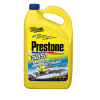Thor1950
Well-Known Member
- Posts
- 39,238
- Location
- Land of the midnight sun
So bottom line freelanders take orange not green????? Correct
Read the owners manual what does it say.......... then read the label of the anti freeze. Should be able to figure it out. and color does not mean a thing.as mentioned below
not orange - it has to be OAT! They contain 2-ethylhexanoic-acid or 2-EHA and other organic acids, but no silicates or phosphates. This formula gives longer life, thus replacing the short-lived silicates and phosphates. Many colours reside in this group. General Motors OAT-based DexCool is orange. Volkswagen-Audi has the same formula, but it is pink. Honda has one coolant dyed a dark green, which looks almost black when it is dirty. The corrosion inhibitors in this group are slower acting, but longer lasting. Five years, or 150,000-mile intervals are often recommended in this group of coolants.
rmg24pro - are yu a merkin?


